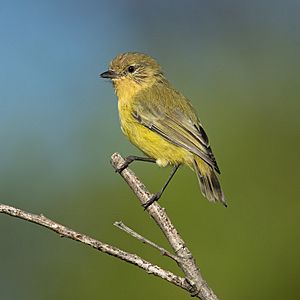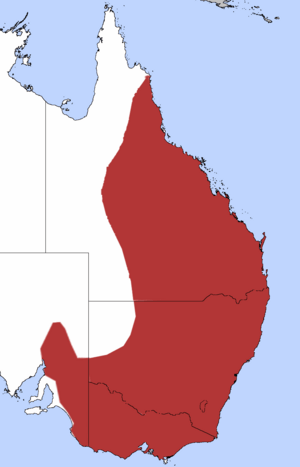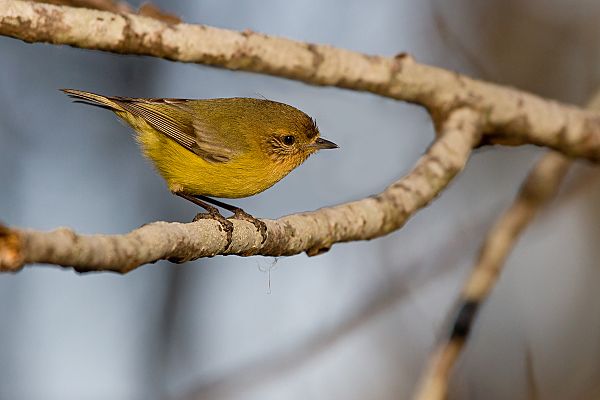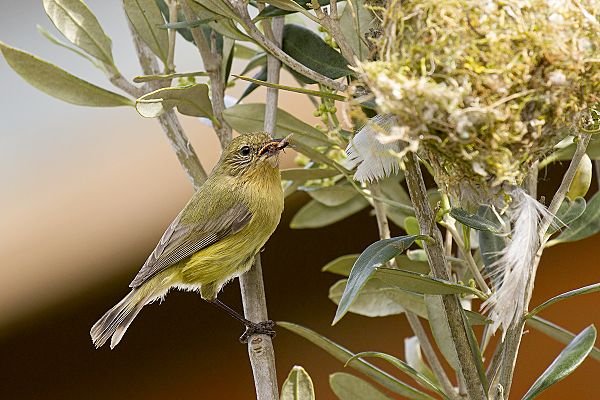Yellow thornbill facts for kids
Quick facts for kids Yellow thornbill |
|
|---|---|
 |
|
| Conservation status | |
| Scientific classification | |
| Genus: |
Acanthiza
|
| Species: |
nana
|
| Subspecies | |
|
|
 |
|
| Distribution of the yellow thornbill | |
The yellow thornbill (Acanthiza nana) is a small bird that lives only on the eastern coast of Australia. It used to be called the little thornbill. Even though it's currently listed as 'Least Concern' by the IUCN, many experts believe its numbers are going down.
Contents
About the Yellow Thornbill's Name
The yellow thornbill was first named Acanthiza nana in 1827. Two scientists, Nicholas Aylward Vigors from Ireland and Dr. Thomas Horsfield from America, gave it this name. They first saw the bird near Sydney Cove.
The name Acanthiza comes from Ancient Greek words. It means 'thorn-brake' (a thorny bush) and 'live, inhabit'. The second part of its name, nana, is a Latin word meaning 'female dwarf'.
The yellow thornbill is one of 13 types of thornbills. All these birds belong to the group called Acanthiza. The yellow thornbill is very similar to the striated thornbill. Another thornbill, the New Guinea thornbill, also looks quite similar.
What the Yellow Thornbill Looks Like
The yellow thornbill is similar in size and shape to the striated thornbill and brown thornbill. However, its yellow color is much brighter. Male and female yellow thornbills look exactly the same.
These birds are about 9 centimeters (3.5 inches) long. Their wingspan is around 14 centimeters (5.5 inches). They are very light, weighing only about 6 to 7 grams (0.21 to 0.25 ounces).
Adult Birds
The feathers on their back are greenish. Their wing feathers are olive-brown with lighter edges. The tail feathers are a bit duller, like the wings. They have a dark brown-black band near the end of their tail.
Their throat and chin are a pale orange color. This blends into a soft, creamy-yellow on their chest. Their legs, toes, and beak are all black. Their eyes are dark brown with a grey ring around them.
The belly of the yellow thornbill is yellow. This color fades to a pale olive on their sides. Their head and ear feathers are olive-grey. They have white streaks above their eyes and on their ear feathers.
Young Birds
Young yellow thornbills look a lot like the adults. However, their feathers are softer and not as bright. When they first leave the nest, their mouth (gape) is still yellow. The yellow feathers on their belly are not as strong. Their back and head feathers are more brown than olive.
Yellow Thornbill Behavior
Reproduction and Life Cycle
Yellow thornbills usually breed in pairs. But in some places, groups of birds have been seen helping each other raise young. Their nests are round and shaped like a dome. They have a small opening near the top.
Nests are usually made from tree bark fibers and grasses. These materials are held together with spider webs. They build their nests in the upper parts of bushes and small trees. Female birds lay two to four eggs. The eggs hatch after about 16 to 17 days.
Calls and Sounds
The yellow thornbill makes a loud, two-note call that sounds like tzid-id. This call is different from the calls of other thornbills. It sounds harsher and less like an insect.
They repeat this call often throughout the day. They use it to stay in touch with other birds while looking for food. They also use it to defend their territory or to show where they are.
Eating Habits and Diet
Sometimes, yellow thornbills gather in large groups to feed. These groups can have up to 35 birds. They can also be found with other types of birds in mixed feeding groups. More often, though, they are seen in smaller groups or pairs.
They like to search for food in the upper and middle parts of forest trees. They move quickly through the outer leaves looking for food. They also look under tree bark. Their diet is mostly insects. However, they will sometimes eat seeds. They can also catch insects while flying.
Where Yellow Thornbills Live
Yellow thornbills mostly live in areas with mild or dry climates. Their habitat stretches into subtropical zones too. They can be found in many different places. These include shrublands, forests, and thickets. They prefer areas with lots of casuarina or eucalypt trees. This is especially true in drier areas.
Their home range goes from northern and central-west Queensland. It then goes south along the eastern coast of Australia. This includes much of New South Wales, all of Victoria, and the Australian Capital Territory. It also reaches into the southeastern part of South Australia.
Protecting Yellow Thornbills
The IUCN Red List currently lists the yellow thornbill as 'Least Concern'. This means they are not in immediate danger. However, their population numbers are going down.
In towns and industrial areas, yellow thornbills are only found in older parts. They are not seen in newer developed areas. This is because native plants are often removed when new areas are built. This removal of plants causes native bird populations to decrease.
Fires also affect their numbers. After a fire, only the oldest birds might be left. Yellow thornbills are not found on farmland that is harvested often. Things like fires, new buildings, farm chemicals, and climate change are also reducing insect numbers. Since yellow thornbills eat mostly insects, this could cause big problems for them in the future.
See also
 In Spanish: Acantiza enana para niños
In Spanish: Acantiza enana para niños




